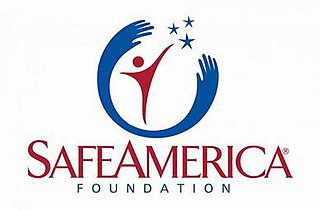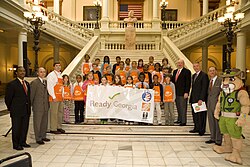
The Federal Emergency Management Agency (FEMA) is an agency of the United States Department of Homeland Security (DHS), initially created under President Jimmy Carter by Presidential Reorganization Plan No. 3 of 1978 and implemented by two Executive Orders on April 1, 1979. The agency's primary purpose is to coordinate the response to a disaster that has occurred in the United States and that overwhelms the resources of local and state authorities. The governor of the state in which the disaster occurs must declare a state of emergency and formally request from the President that FEMA and the federal government respond to the disaster. The only exception to the state's gubernatorial declaration requirement occurs when an emergency or disaster takes place on federal property or to a federal asset—for example, the 1995 bombing of the Alfred P. Murrah Federal Building in Oklahoma City, Oklahoma, or the Space Shuttle Columbia in the 2003 return-flight disaster.
Preparations for earthquakes can consist of survival measures, preparation that will improve survival in the event of an earthquake, or mitigating measures, that seek to minimise the effect of an earthquake. Common survival measures include storing food and water for an emergency, and educating individuals what to do during an earthquake. Mitigating measures can include firmly securing large items of furniture, TV and computer screens that may otherwise fall over in an earthquake. Likewise, avoiding storing items above beds or sofas reduces the chance of objects falling on individuals.

George Ervin "Sonny" Perdue III is an American politician who served as the 31st United States secretary of agriculture from 2017 to 2021. A member of the Republican Party, he previously served as the 81st governor of Georgia from 2003 to 2011 and as a member of the Georgia State Senate from 1991 to 2002.

A humanitarian crisis is defined as a singular event or a series of events that are threatening in terms of health, safety or well-being of a community or large group of people. It may be an internal or external conflict and usually occurs throughout a large land area. Local, national and international responses are necessary in such events.
Public Safety Canada, legally incorporated as the Department of Public Safety and Emergency Preparedness (PSEPC), is the department of the Government of Canada responsible for (most) matters of public safety, emergency management, national security, and emergency preparedness in Canada.

Emergency management or disaster management is a science and a system charged with creating the framework within which communities reduce vulnerability to hazards and cope with disasters. Emergency management, despite its name, does not actually focus on the management of emergencies, which can be understood as minor events with limited impacts and are managed through the day-to-day functions of a community. Instead, emergency management focuses on the management of disasters, which are events that produce more impacts than a community can handle on its own. The management of disasters tends to require some combination of activity from individuals and households, organizations, local, and/or higher levels of government. Although many different terminologies exist globally, the activities of emergency management can be generally categorized into preparedness, response, mitigation, and recovery, although other terms such as disaster risk reduction and prevention are also common. The outcome of emergency management is to prevent disasters and where this is not possible, to reduce their harmful impacts.

A survival kit is a package of basic tools and supplies prepared as an aid to survival in an emergency. Civil and military aircraft, lifeboats, and spacecraft are equipped with survival kits.

Disaster response refers to the actions taken directly before, during or in the immediate aftermath of a disaster. The objective is to save lives, ensure health and safety and to meet the subsistence needs of the people affected. This includes warning/evacuation, search and rescue, providing immediate assistance, assessing damage, continuing assistance and the immediate restoration or construction of infrastructure. The aim of emergency response is to provide immediate assistance to maintain life, improve health and support the morale of the affected population. Such assistance may range from providing specific but limited aid, such as assisting refugees with transport, temporary shelter, and food to establishing semi-permanent settlements in camps and other locations. It also may involve initial repairs to damage or diversion to infrastructure.
Preparedness is a set of actions that are taken as precautionary measures in the face of potential disasters. Being prepared helps in achieving goals and in avoiding and mitigating negative outcomes.
Citizen Corps is a program under the Department of Homeland Security that provides training for the population of the United States to assist in the recovery after a disaster or terrorist attack. Each local Citizen Corps Council partners with organizations, volunteers and businesses to organize responders, volunteers and professional first responders for an efficient response so efforts are not wasted by being duplicated. By training in Incident Command, volunteers know whom to report to and how the incident is organized. This prevents sites from being inundated by untrained and unprepared personnel preventing operation. Citizen Corps also works in conjunction with the Corporation for National and Community Service in promoting national service opportunities for promoting homeland security needs.

The 2008 Atlanta tornado outbreak was a destructive and deadly tornado outbreak that affected the Southeastern United States on March 14–15, 2008. The most infamous tornado of the outbreak occurred on March 14 when an isolated but strong EF2 tornado caused widespread damage across Downtown Atlanta, Georgia, including to the CNN Center and to the Georgia Dome, which was hosting the 2008 SEC men's basketball tournament. Other buildings that were damaged include the Georgia World Congress Center, Philips Arena during an Atlanta Hawks game, and the Omni Hotel, which was evacuated after many windows were blown out. The Westin Peachtree Plaza Hotel suffered major window damage. The image of the building with all its windows blown out became famous and for a time was a symbol of the tornado. Centennial Olympic Park, SunTrust Plaza and historic Oakland Cemetery were also damaged.

The Administration for Strategic Preparedness and Response (ASPR) is an operating agency of the U.S. Public Health Service within the Department of Health and Human Services that focuses preventing, preparing for, and responding to the adverse health effects of public health emergencies and disasters. Its functions include preparedness planning and response; building federal emergency medical operational capabilities; countermeasures research, advance development, and procurement; and grants to strengthen the capabilities of hospitals and health care systems in public health emergencies and medical disasters. The office provides federal support, including medical professionals through ASPR’s National Disaster Medical System, to augment state and local capabilities during an emergency or disaster.

In the United States, a public health emergency declaration releases resources meant to handle an actual or potential public health crisis. Recent examples include:
The California Governor's Office of Emergency Services is a California cabinet-level office responsible for overseeing and coordinating emergency preparedness, response, recovery and homeland security activities within the state. The agency was created by AB 38 (2008), superseding both the Office of Emergency Services (OES) and Office of Homeland Security (OHS).
The September 2009 Southeastern United States floods were a group of floods that affected several counties throughout northern Georgia, Tennessee, Alabama, Mississippi, and Arkansas. The worst flooding occurred across the Atlanta metropolitan area. Continuous rain, spawned by moisture pulled from the Gulf of Mexico, fell faster than the local watersheds could drain the runoff.
The Canadian Centre for Emergency Preparedness (CCEP) was a Canadian, federally incorporated, not-for-profit organization that encouraged and promoted disaster management elements and practices to organizations, communities, and individuals in both the public and private sectors. CCEP's aim was to reduce the risk, impact and cost of disasters. CCEP was established in 1993. In 2013, it ceased operations and transferred its assets to the Emergency Management and Public Safety Institute (EMPSI) of Centennial College, Toronto, Ontario. It formally dissolved on January 22, 2014.

The Safe America Foundation is a 501(c)(3) non-profit organization working nationally and headquartered in Marietta, Georgia. The organization was founded in 1994 and partners with corporate, government, public and private sector organizations and non-profit organization to improve the awareness of safety and preparedness in the United States. The Safe America Foundation operates an Emergency Preparedness program and Driver Education program.
"Preparedness 101: Zombie Apocalypse" is a blog post made in May 2011 by the United States Centers for Disease Control and Prevention (CDC) that uses a zombie apocalypse to raise public awareness of emergency preparedness. In a blog post titled "Preparedness 101: Zombie Apocalypse", the director of the CDC's Office of Public Health Preparedness and Response, Rear Admiral Ali S. Khan writes: "Take a zombie apocalypse for example. That's right, I said z-o-m-b-i-e a-p-o-c-a-l-y-p-s-e. You may laugh now, but when it happens you'll be happy you read this, and hey, maybe you'll even learn a thing or two about how to prepare for a real emergency." Comparing the upcoming hurricane season and possible pandemics to "flesh-eating zombies" from the horror film Night of the Living Dead and the video game series Resident Evil, Khan recommends Americans prepare for natural disasters as they would have prepared for "ravenous monsters". The blog post was part of a larger zombie-themed campaign retired by mid-2022 and replaced with the Prep Your Health CDC website.
Crisis Preparedness and Response Centre is the agency established by the Government of Malaysia under the 9th Malaysian Plan (2005–2010) as part of the overall strategy for effective disaster preparedness, outbreaks, crises and emergencies related to health The opening of the CPRC was conducted by Malaysian Health Minister Datuk Seri Chua Soi Lek on May 7, 2007. The CPRC is located at Level 6, Block E10, Complex E, Federal Government Administrative Center, Putrajaya.
The preparedness paradox is the proposition that if a society or individual acts effectively to mitigate a potential disaster such as a pandemic, natural disaster or other catastrophe so that it causes less harm, the avoided danger will be perceived as having been much less serious because of the limited damage actually caused. The paradox is the incorrect perception that there had been no need for careful preparation as there was little harm, although in reality the limitation of the harm was due to preparation. Several cognitive biases can consequently hamper proper preparation for future risks.











